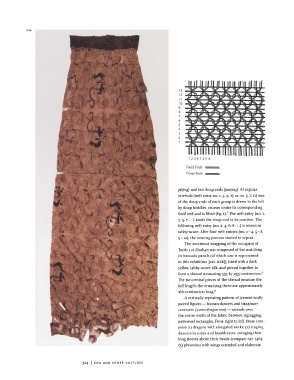Page 325 - The Golden Age of Chinese Archaeology: Celebrated Discoveries from the People’s Republic of China
P. 325
1123
13
12
11
10
9
8
7
6
5
4
3
2
1
1 2 3 4 1 2 3 4
Fixed Ends
Doup Ends
(dijing) and two doup ends (jiaojing). At regular
intervals (weft entry no. i, 5, 9,13 or no. 3, 7, n) one
of the doup ends of each group is drawn to the left
by doup heddles, crosses under its corresponding
7
fixed end and is lifted (fig. i). The weft entry (no. i,
3, 5, 7 ...) binds the doup end in its position. The
following weft entry (no. 2, 4, 6, 8 ...) is woven in
tabby weave. After four weft entries (no. i - 4, 5 - 8,
9-12), the weaving process started to repeat.
The outermost wrapping of the occupant of
Tomb i at Mashan was composed of five matching
;m-brocade panels (of which one is represented
in this exhibition [cat. H2b]), lined with a dark
yellow, tabby-weave silk, and pieced together to
form a shroud measuring 333 by 233 centimeters. 8
The two central pieces of the shroud measure the
full length, the remaining three are approximately
166 centimeters long. 9
A vertically repeating pattern of symmetrically
paired figures — human dancers and imaginary
creatures (wuren dongwu wen) — extends over
the entire width of the fabric between zigzagging
patterned rectangles. From right to left, these com-
prise (i) dragons with elongated necks; (2) singing
dancers in robes and headdresses, swinging their
long sleeves above their heads (compare cat. 146);
(3) phoenixes with wings extended and elaborate
324 | CHU AND O T H E R C U L T U R E S

